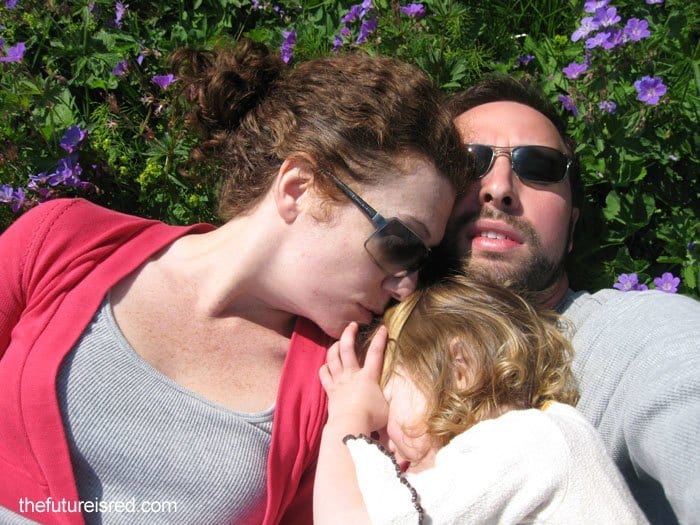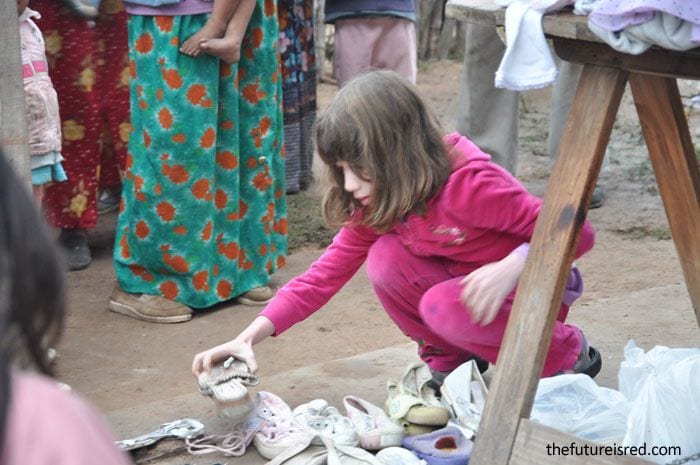I started volunteering during the summer when I was 11 years old. It started when my dad worked at the Red Cross in Arkansas, and he brought me along to help.
I didn’t realize it at the time, but my mornings teaching adorable five and six year olds to swim set the foundation for my life philosophy and how I would approach people, other cultures, and the world in general.
Since then, I’ve baked cupcakes to raise money for school supplies in Panama, cut fruit to feed monkeys and bears in Bolivia and taught art and photography classes to children in tiny villages in Argentina.
Now, as an adult traveling with my daughter, we do volunteer work together. The experience is enriching and educational, for both my daughter and me, but it’s also a lot more than that. As she works along beside me, it’s a bonding moment between us.
If you’ve ever considered volunteering with your child while traveling, here are some of the reasons why you should volunteer work.
Why Volunteer With Your Child When You Travel?

I read this interesting article by a woman named Pippa Biddle, who wrote about the problematic nature of volunteering.
Her main point being that unless you have the experience to volunteer, it’s best to stay home.
Obviously, most children don’t have extensive international aid experience. They are more needy than the average adult and are usually less able to control themselves – perhaps leading you to question whether volunteering with children is a good idea.
Some may call it irresponsible to bring a child with you, I do not believe that to be the case.
Of course, we are not talking about medical volunteer work or running into a war zone to care for injured people. There are so many types of volunteer work you can do that has an impact, but doesn’t require specialist training or skills.
Here’s a few good reasons why you should volunteer with your kids on your travels…
1. You will learn amazing things while volunteering

Children are capable of incredible things, and too often adults underestimate what they can do.
Volunteering requires a high degree of maturity, patience and kindness. All of which are qualities children possess and are more than able to further cultivate.
My daughter, Lila, has learned responsibility. She took on the job of feeding birds and not only made sure they ate on time every day but remembered to prepare a special dish for the toucan.
She gained skills and knowledge through her volunteer experiences.
Lila learned what monkeys and birds eat, not in a classroom or from a video, but because she fed and cared for animals at a natural habitat wildlife refuge.
She also understands the importance of preserving their environment, because she has seen first hand what happens to those animals when their forests are destroyed.
Working alongside local communities in need helps children develop empathy and compassion as they witness firsthand the challenges faced by others and the power of making a positive impact.
2. Children can learn other languages
Lila can also handle herself in different cultures and in different languages. In truth, we learn language far more quickly before adolescence. What better way to learn than through real world communication?
Traveling and volunteering with Lila have deepened not only her independence but my confidence that Lila can handle herself.
Volunteering abroad with your kids is an enriching and transformative experience that offers numerous benefits for both you and your children. Here are some compelling reasons to consider:
3. It gives them global awareness
Volunteering abroad raises awareness about global issues like poverty, lack of education, and environmental and sustainability issues.
It can be very empowering for children to see first hand some of the shortfalls of this world and put them on the path to becoming informed global citizens.
They will return home with a new-found respect for the world, and can think deeper and more empathetically than their friends at home.
4. Develops skills
Volunteering offers opportunities for children to develop valuable skills such as communication, problem-solving, teamwork, and adaptability.
Of course, they can learn all these things in schools, but when learning these skills outside a classroom they are putting what they learn to good use in the real world. This is far more beneficial in my book.
5. They get outside the classroom education
If you want a child to remember something they’ve learned, the best way to ensure this is to make sure they are learning in context and putting what they learn to good use.
The best way to learn about anything, is to learn by doing.
Volunteering provides hands-on learning opportunities that is far more impactful and useful than what they can learn in formal education. We’re not talking just practical skills, but valuable life lessons, too.
6. The blueprint to becoming a better person
Volunteering is all about making a difference. Volunteering empowers children to make a positive impact on the lives of others, fostering a lifelong commitment to giving back and creating a better world.
As they grow older, they will grow up more compassionate and considerate of others, which in turn, will help them to grow up to be a better person.
Tips For Volunteering With Your Children

It’s important to remember that volunteering comes with guidelines. These tips will help ensure a safe and positive experience for you and your child.
1. Your child must be part of the decision making process
Talk to your children before volunteering to make sure it’s what they want to do and that they understand exactly what is expected of them.
Ensure they know all their duties and that it’s an important role they play. They need to understand they can’t just give up if they are bored, or that they can’t forget to feed the cat one day.
If they are not totally onboard, then you may want to rethink the kind of volunteer work you do. Top tip; kids usually enjoy volunteer work that works with animals.
2. Ask the NGO or organization if they allow children
Many places will automatically say no. That is their prerogative. The work they do may be dangerous or they don’t have the appropriate resources to support a child.
Even if an organization has a no children policy, it never hurts to ask if they’ll make an exception. Don’t push if it’s not a good fit.
3. Find out what work you will be doing
Not every volunteer group will have a clear outline of the work, so it is up to you to ask questions, contact past volunteers and talk to people at the organization to find out how you can be most helpful and what work you will be doing.
You can also offer additional skills you may possess.
4. Pack well and carefully
Many volunteer organizations will have a list of what you’ll need to pack and how to prepare for your trip. If you can’t find one, ask.
While many organizations provide for your basic needs, it’s best to be as self sufficient as possible so as not to be a drain on resources.
Also, check to see if you can buy food, water, first aid and other items nearby should the need arise.
5. Prepare for the trip together
There are many ways to build excitement and create clear expectations for your trip prior to your departure date.
You can pack together, purchase whatever items you need, research the subject and even learn a language.
6. Work up to a long trip
Don’t start by dragging your child from home where they’ll be surrounded by people who speak a different language and living without their usual amenities.
Instead, start with something more simple. Find volunteer opportunities closer to home.
Before You Go
Before you go, remember it is all about attitude.
It is indeed problematic if a volunteer walks into a community thinking of himself as someone who is there to bestow knowledge on a people who don’t know.
It is even worse when volunteers use resources that would be better left to the community. If, however, you enter the community with the desire to learn and a willingness to take instruction, you send a different message.
I’ve found that showing up with a child allows me to integrate more seamlessly into the local community, because the role of parent cuts through all cultural and language boundaries.
When Lila sits on the dirt floor of a one room church in a tiny village with no running water and no electricity and draws with a child her own age, she builds relationships based on common experience.
When you treat people with respect and are considerate of their time and culture, you teach your children that money, privilege and color of skin do not determine worth or friendship, and that is an incredibly powerful lesson for all.
Have you volunteered with your children? Share your experiences and tips in the comments below.
We spent a month last September volunteer English teaching at a high school in rural Thailand with our 2 and 6 year olds. We spent the month living with a Thai family in their home in a small village. This was an amazing experience for our family and something our kids still talk about often. It wasn’t always easy – long days at school, hot weather, fussy eaters etc but the positives by far outweighed the negatives.
Hi Madeline,
I completely agree. Whenever I tell people about my trip to the Bolivian monkey sanctuary with Lila, they tell me it sounds pretty awful. Hard, dirty work. We had some issues with the other volunteers who didn’t think Lila should be there. (The owners were happy to have her, so I took their lead.)
But Lila and I remember it as wonderful. She learned a lot, and I absolutely loved my time with her and getting to know her in a way I wouldn’t have had we stayed at home for summer vacation.
If you have a chance, I’d love to know details of where you volunteered in Thailand. Thailand is top of my list of places to travel, and perhaps we could do the same. 🙂
Hi Leigh, sorry, I just came back to this and saw your question. I wrote all about how we organised our experience here: http://theplaceswegoblog.wordpress.com/2013/09/25/how-we-arranged-our-family-volunteering-placement-in-thailand-and-how-volunteering-with-kids-worked/
No worries. Heading there now to take a look. 🙂
Now that’s really interesting, and thinking anout it, probably the best way for kids to volunteer IS with their parents. My teen’s son has a program taking the kids to Costa Rica, which I mist say I do have some issues with and I was glad he didn’t want to do it… but if he could apprentice himself tome, as kids do, and be helpful and useful, that would be SO good.
Hi Seana,
I agree. I don’t think there’s a better way for kids to learn than learning by example from their parents. I’m curious to know what were the issues you had with the Costa Rica trip. There are some great volunteer programs out there, but it is so important to be careful and really know what they are.
Most of our volunteering has been through direct contact with organizations and NGOs. I haven’t been on any organized trips.
Very interesting work! It’s great for parents to expose their kids to this kind of thing. This is a must read!
Thank you, Jorga. I’m glad you enjoyed the piece. Yes, I have some very strong opinions on volunteering in general, but it’s been such an amazing experience for us as a family, I do encourage others to do the same. 🙂
What you kidos and children see in your actions and lifestyle are what they imitate. It so important to volunteer with your children to have bonding and for them to expereince love nad support.
I couldn’t agree with you more, Macky. There’s no better way to parent than by example. It’s also infinitely easier than trying to get a kid to do something by just talking to them.
I don’t have kids, so I can’t share any real experience. But being that one of the main things about parenthood is passing on your values, volunteering is a great opportunity. It’s a way for kids to learn in a hands-on, practical way.
Deia,
I think just being supportive of parents who travel and volunteer with their kids is a wonderful thing. I didn’t write about it in the article bc it didn’t fit, but we’ve run into some people — always other volunteers, never NGO or org owners — who so vehemently believed kids shouldn’t be volunteers that it made life very unpleasant.
The people who didn’t have kids but supported us, spent time with Lila and treated us like human beings have been invaluable to our experiences.
That’s nice you have been volunteering with your children. At least you are giving quality time with them. I had 1 daughter and I also volunteered with her in her school activities. Volunteering is a great opportunity for us to offer time, love and support for them.
Marie,
So very true. It creates a really wonderful connection.
These sound like good guidelines for volunteering with kids. However, I do agree with all the cautionary articles out there against “voluntourism” as well, and I think it’s worth people getting acquainted with the arguments before choosing a project. Volunteering at orphanages has come under particular scrutiny for the attachment problems short-term placements can cause, and building projects by unskilled tourists are the other ones that seem to get the most bad rap.
Your points about choosing a program that’s a good fit and going in prepared to hit the ground running on a specific task are great ones to keep in mind.
The point about volunteering closer to home also shouldn’t be missed. A lot of people (children included) are going to be most effective locally, and it can be more easily folded in to the everyday routine.
We haven’t volunteered outside our local area as a family yet, but I’ve been invited to bring the kids along to a project I volunteered at last year and I know exactly what they could do there. But I would take them, feeling as if I understand the effect of their net contribution on the local community (roughly none – at 3 and 5 it would be for their own development, but at least they’re not going to do any harm, either).
Bronwyn,
I couldn’t agree more with your points about voluntourism. My husband and I run an NGO in NW Argentina, and we recently stopped taking volunteers very much for those reasons. Now, we only accept people on a limited basis, and they have to arrive with prior experience.
Lila joins us when we visit our local communities and helps and has done so for the past few years. We don’t in anyway allow people to pay to visit our communities as part of a tour. Quite frankly, I don’t have the time or patience to work with people who are more interested in seeing what’s out there instead of getting a bit dirty and helping.
The work you’ve done sounds interesting as well. You’re giving your two little ones a really wonderful foundation on which they can build experience.